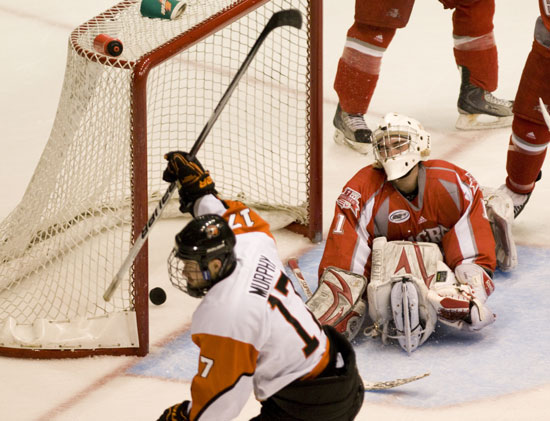Recruiting Champions Without Athletic Scholarships
RIT scholar-athletes are tops in hockey stats and on the dean’s list
RIT Athletics
Sean Murphy celebrates his second goal of the game against Sacred Heart in a 6-1 victory that gave the RIT men’s hockey team its first berth in the NCAA Frozen Four tournament.
Team chemistry—and chemistry classes—draw some of the finest student-athletes to Rochester Institute of Technology.
As the RIT Tigers men’s hockey team prepares for its first Frozen Four appearance, there is a sense of fascination that a successful team can be built without the incentive of athletic scholarships. Athletes are drawn to RIT for the same reasons that any student would be—from academic programs to career opportunities.
Because only one of RIT’s 24 sports moved to Division I—the other teams compete at Division III—the hockey team is not able to offer scholarships. And yet some hockey programs like Clarkson and Rensselaer Polytechnic Institute are grandfathered by an NCAA ruling and do allow scholarships for hockey players.
So when RIT announced it would go Division I in hockey on Dec. 15, 2004, some were skeptical that the team could win without granting athletic scholarships. But Head Coach Wayne Wilson was confident that excellent players would choose RIT.
“We offer a product of tremendous value: a degree from RIT, great facilities and the Rochester community as a whole,” he told the media in 2004.
Al Simone, RIT president at the time of the move to D-I, is not surprised Coach Wilson has found outstanding student-athletes.
“We said we would not recruit a student, no matter how strong an athlete he might be, unless we believed he would be strong academically as well,” Simone, who will travel to the Frozen Four in Detroit, recalled this week. “We were prepared to increase the recruiting budget significantly so that the coaches could recruit all over the country and Canada to look for that outstanding student—in terms of academics and character—who could also play great hockey.”
And find them, they did, said Associate Head Coach Brian Hills who recruits throughout the U.S. and Canada.
“We look for strong character players. We look for skill guys, guys who skate, handle the puck and shoot well,” says Hills. “Even defensemen put up points with our team, that’s a big part of our game. In today’s college game, you don’t need a whole bunch of 6’ 2” to 6’5” guys, you can get away with one or two being 5’ 8” or 9” as long as they skate well, make plays and possibly score goals.”
His approach to recruiting includes persistence, integrity and being able to make a case for strong academics and an equally strong athletic program. RIT is not unusual in its emphasis on academics.
“Cornell and Yale are also financial aid schools that consistently put strong teams on the ice,” he says.
Athletic scholarships for student-athletes at Division I and Division II universities are partially funded through the NCAA membership revenue, according to the NCAA. This accounts for approximately $1 billion for full or partial scholarships to just over 125,000 athletes.
It is common for college players today to come from the junior hockey ranks, Hills explains. It is very tough for high school hockey players to make the jump directly to the Division I level. Many players who aspire to college and professional hockey begin at the junior level while still underclassmen in high school. Some head to junior hockey for one or two years after high school.
One such player at RIT is Sean Murphy, a rugged forward from Owatanna, Minn. He was a multi-sport athlete, captaining his high school hockey and soccer teams. He also played for the United States Hockey League, the only Tier One junior league in the U.S., on teams in Green Bay, Wis., and Waterloo, Iowa.
“When Coach Hills talked to me the first time, all he could talk about was the education and how someone like me would find it very beneficial. RIT had a lot to offer educationally,” says Murphy, a fifth-year civil engineering technology major in the RIT College of Applied Science and Technology. He initially put RIT on the back burner, opting for an additional year of junior hockey before re-contacting Hills. “Once I got here and met the guys on the team, I kind of fell in love with the place.”
He received an academic scholarship and resides in an on-campus apartment with several teammates. He is currently on co-op with Clark Patterson and Lee, a multi-service civil and municipal engineering firm.
“RIT is an ideal place for athletes because of the consistent philosophy that students can be successful in many aspects of their lives, not just sports,” says Mary Beth Cooper, vice president for Student Affairs. “The student-athletes at RIT have goals beyond sports that include challenging and interesting careers.”
The men’s hockey team carries a 3.30 GPA. Murphy has twice been named to the Atlantic Hockey Association All-Academic team, maintaining a GPA average 3.0 or better over his academic career.
“Sean is a great student who wanted engineering or science, so RIT was a good fit for him,” says Hills. “Sean is an exceptional young man. He’s a great leader. We look for guys who are warriors, and if you’ve ever seen him play, you can see that he is—and off the ice, he’s a gentleman.”
The scholarships for athletics are incidental, Murphy says. The point he and many of his teammates make is that they want to be at RIT. “Guys chose to come here—even with other offers—just because they like the coaches better, they like the program better and the educational aspect as well.
“It comes down to what you want more,” Murphy says. “With an education from RIT, people are willing to pay for it because it gives you a lot of great returns later on in life.”














